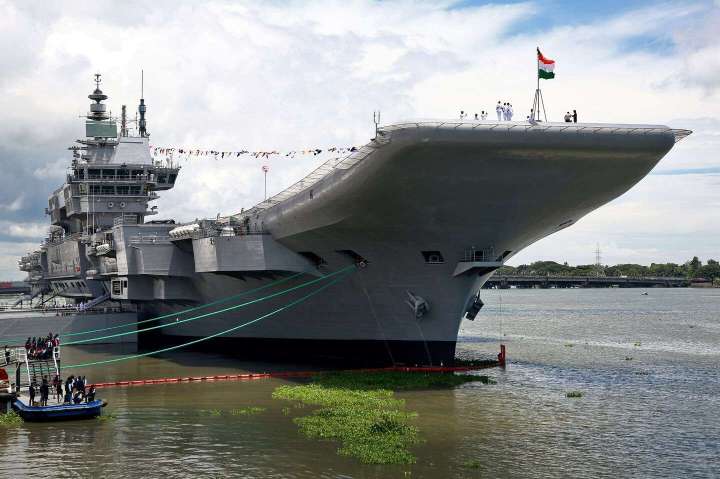NEW DELHI — India on Friday commissioned its first domestically built aircraft carrier, joining a small club of countries with the capacity to manufacture the warships — and use them to project power far from their shores.
India launches first locally built aircraft carrier amid rivalry with China

At a ceremony in Kerala state, Prime Minister Narendra Modi called the construction of the vessel a milestone in India’s pursuit of technological self-reliance and defense manufacturing, and he alluded to his country’s new strategic outlook.
“In the past, security concerns in the Indo-Pacific region and the Indian Ocean have long been ignored,” Modi said. “But today, this area is a major defense priority. That is why we are working in every direction, from increasing the budget for the navy to increasing its capability.”
Since 2020, India and China have been locked in a bitter border dispute in the Himalayas, but tensions have spilled into the maritime domain. In August, a Chinese navy ship docked in Sri Lanka despite protests from India, triggering a diplomatic spat between New Delhi and Beijing. The typically reserved Indian government also issued blunt warnings about the “militarization” of the Taiwan Strait after China held military drills last month in response to a visit to Taiwan by U.S. House Speaker Nancy Pelosi (D-Calif.).
While military experts say that modern-day carriers are increasingly vulnerable to missiles and submarines in the event of war, the ships are still widely seen as a symbol of national prestige and crucial for conducting far-flung operations.
Aside from India, many countries in the increasingly contested Indo-Pacific region are investing heavily in their navies. In June, China unveiled its own first domestically built carrier that uses electromagnetic catapults to sling aircraft off its deck — a technology that only the United States previously deployed. Japan, a U.S. ally today, is building out the Izumo, the largest warship the country has produced since its defeat in World War II, into a light carrier. South Korea also is planning to launch aircraft carriers at the end of the decade to counter China.
When the Vikrant enters service sometime in late 2023, India will be one of five countries that operate two carriers. The ship is designed to carry a full complement of 30 aircraft, including fighters that will be catapulted off its “ski-jump” deck.
The Vikrant, along with India’s other carrier, the INS Vikramaditya, a refurbished Soviet-era vessel purchased in 2004 from Russia, will lead the navy’s strike groups.
Ajai Shukla, a commentator on military affairs and a former Indian army officer, said the Indian military and policymakers have been debating whether the navy would eventually need three or even four carriers to meet the strategic aim of denying China access to the Indian Ocean in case of conflict.
“When India is talking about how to build up naval strength, it’s in the context of how to dominate the Arabian Sea, which it shares with Pakistan, and how to dominate the Bay of Bengal down to the Malacca Strait to deny China entry,” Shukla said. “India has clearly gone with the side of the argument that says, ‘You need aircraft carriers.’ ”
Successive U.S. administrations have sought to cultivate naval cooperation with India, which they have viewed as a crucial counterweight to China. The four countries of the Quad partnership — the United States, Japan, Australia and India — have held two naval exercises since 2020, and India sent a frigate in June to join drills with the U.S. Navy near Hawaii. China has viewed the deepening relationship with alarm and accuses the United States of re-creating Cold War-style blocs in the 21st century.
Although the new Indian carrier was assembled domestically, many key components were imported. The carrier will be powered by generators from General Electric and will use radars from Israel. Its fighter aircraft wing will contain Russian MiGs, French Dassault Rafales or American F/A-18 Hornets, but not Indian aircraft.
For years, Indian officials have sought to obtain cutting-edge American technology — including the electromagnetic catapults used on carriers and advanced jet engines. But talks between the two governments have often yielded little, with India reluctant to draw too close to Washington and the United States reluctant to share sensitive technology, said Rajeswari Pillai Rajagopalan, a former official in India’s National Security Council Secretariat who is now at the Observer Research Foundation think tank in New Delhi.
That could soon change.
China — which has the world’s largest naval fleet — surprised many observers, including in New Delhi, with the technology onboard the new carrier it unveiled this year, Rajagopalan said.
“China in the last decade has demonstrated it has significantly improved its competitiveness,” she said. “You can expect a greater sense of urgency from the Indian side to work with the U.S. and build up its naval strength.”






